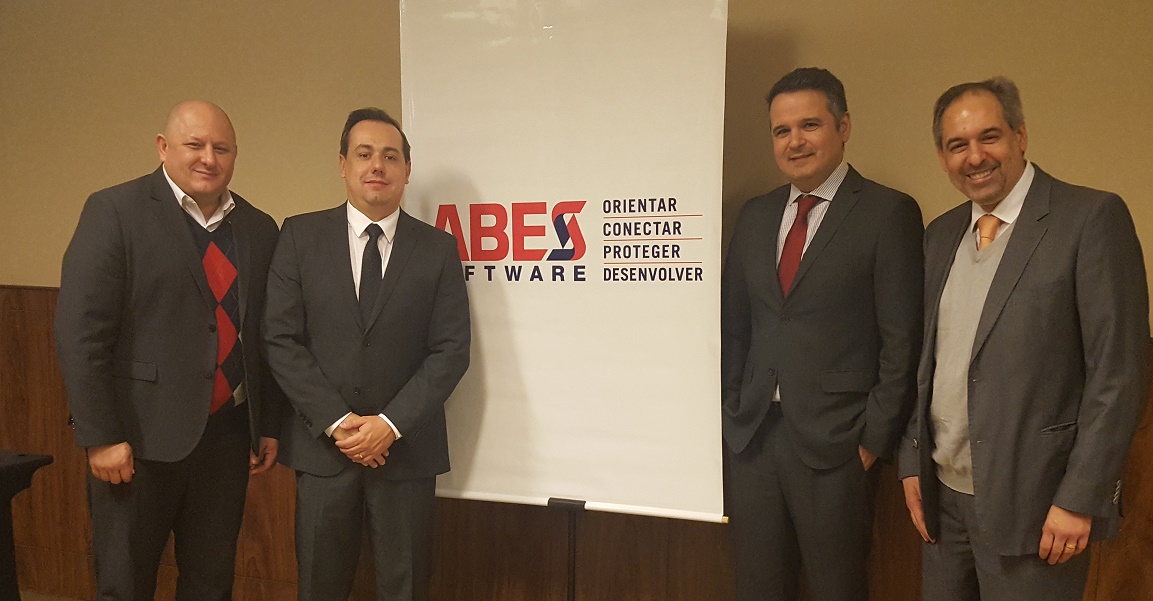
Stutz, Bozza, Corte Real and Pitanga
“How do you capitalize on protecting your software's intellectual property?” was the theme of the meeting for ABES members, held by the entity's Intellectual Property Committee, led by Jefferson Stutz and Paulo Bouzza, coordinators of the committee; Eduardo Pitanga, from BSA I The Software Alliance; Thomaz Côrte Real, the entity's lawyer and legal advisor; and Carol Marzano, coordinator of the ABES committees.
The event took place on August 7, in São Paulo, and the first presentation was given by Pitanga, who explained about the global performance of BSA I The Software Alliance and commented on data from the 2018 Global Software Survey, which quantified the volume and the value of unlicensed software from 110 countries and markets. “In Brazil, the irregular use of software has fallen in recent years and is at 46%. However, it is still a significant percentage when compared to the United States, where the percentage is 16%”. Cloud computing is a business model that has discouraged the irregular use of software, along with educational campaigns and legal actions, with the support of government agencies, manufacturers and even marketplaces.
A cracker (cyber criminal), highlighted the executive, creates malware from the security holes of irregular software that normally does not undergo updates, providing the opportunity to attack equipment or an entire network of computers - an occurrence that affects the functioning, productivity and reputation of small, medium or large companies.
User profiles, combat and legal aspects
About users of irregular computer programs, Stutz explained about the existence of three different profiles. The first is the legality inclined, who, until then, believed the program was legitimate and is more willing to resolve the situation quickly. Then comes the opportunist who, despite preferring regular software, uses a lot more pirated programs, bought with discounts or downloaded from websites. It needs some pressure to normalize its software assets. Finally, we have the user inclined towards piracy, who has no motivation to use legitimate programs and only solves the problem after measures such as audits, extrajudicial notifications and, finally, legal actions.
The coordinator explained that, nowadays, the tendency of the ICT market has been to negotiate with the offenders identified to regularize the situation, even presenting them with the tools to frequently carry out the internal management of software assets in companies and control continuous use of license agreements and acquisitions made. “The irregular user is already an indirect customer of the software manufacturer or distributor. So, regularization is the best way for the entrepreneur, in order to mitigate the legal and financial risks if piracy continues”, ponders Stutz.
Bozza explained the three pillars of the License Compliance Program carried out by ABES, in partnership with BSA and other associations. They are: 1) raising awareness, with campaigns on the correct licensing, clarification of the risks and benefits, highlighting the advantages of being a legal entrepreneur; 2) the conversion, through extrajudicial notifications, audits, SAM – Asset Management Software, control of the sale and distribution of irregular copies, mainly online, among other instruments; 3) prosecution, which are legal actions, which involve damages and other punishments, as defined by the Software Law.
The last presentation was led by Côrte Real, who addressed the legal aspects that guarantee the protection of the intellectual property of a computer program in Brazil, present in articles of the Federal Constitution, the Software Law (9609/98) and together with the Copyright Law No. 9,610/98. “Although the lawsuit is not, normally, the first measure adopted to defend the intellectual property of the software, Brazil has jurisprudence that shows the effectiveness of combating this illicit practice”, he concluded.
.jpg)













